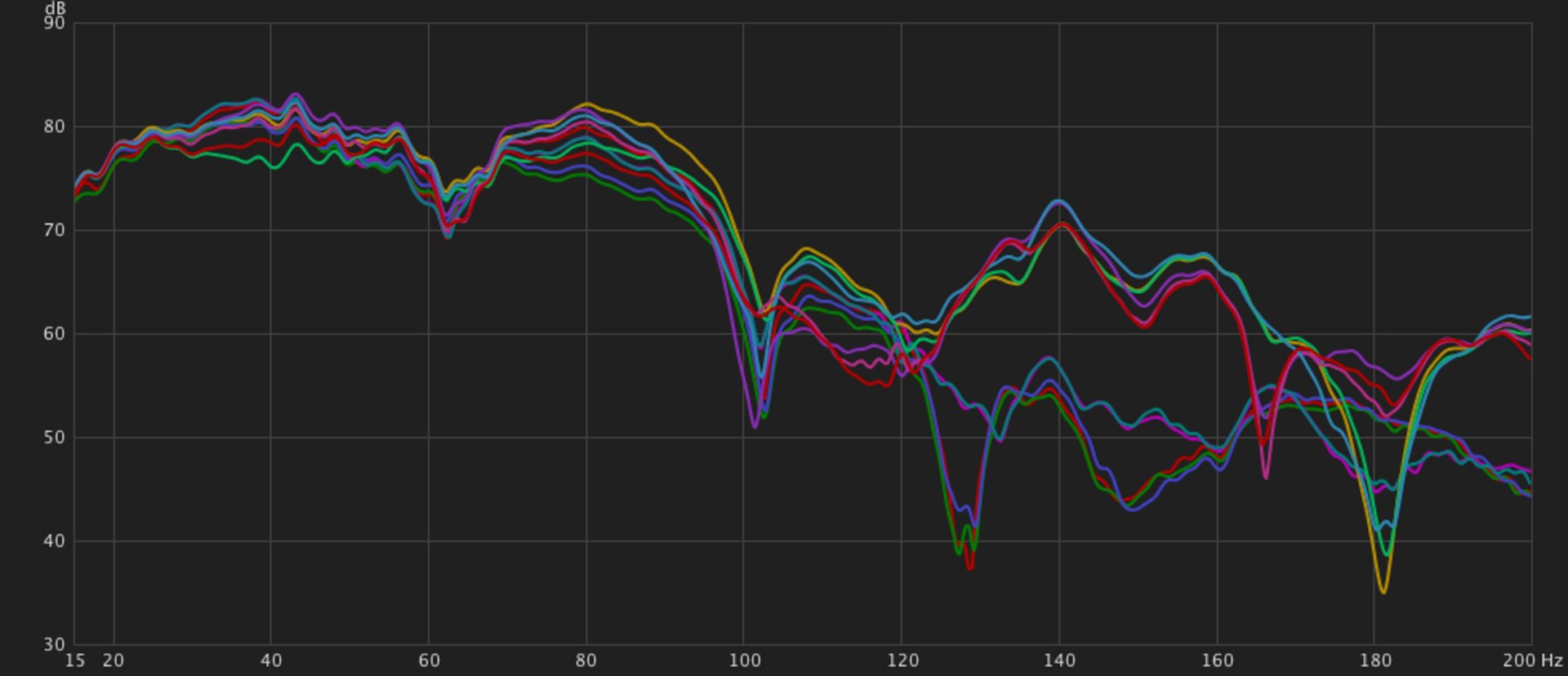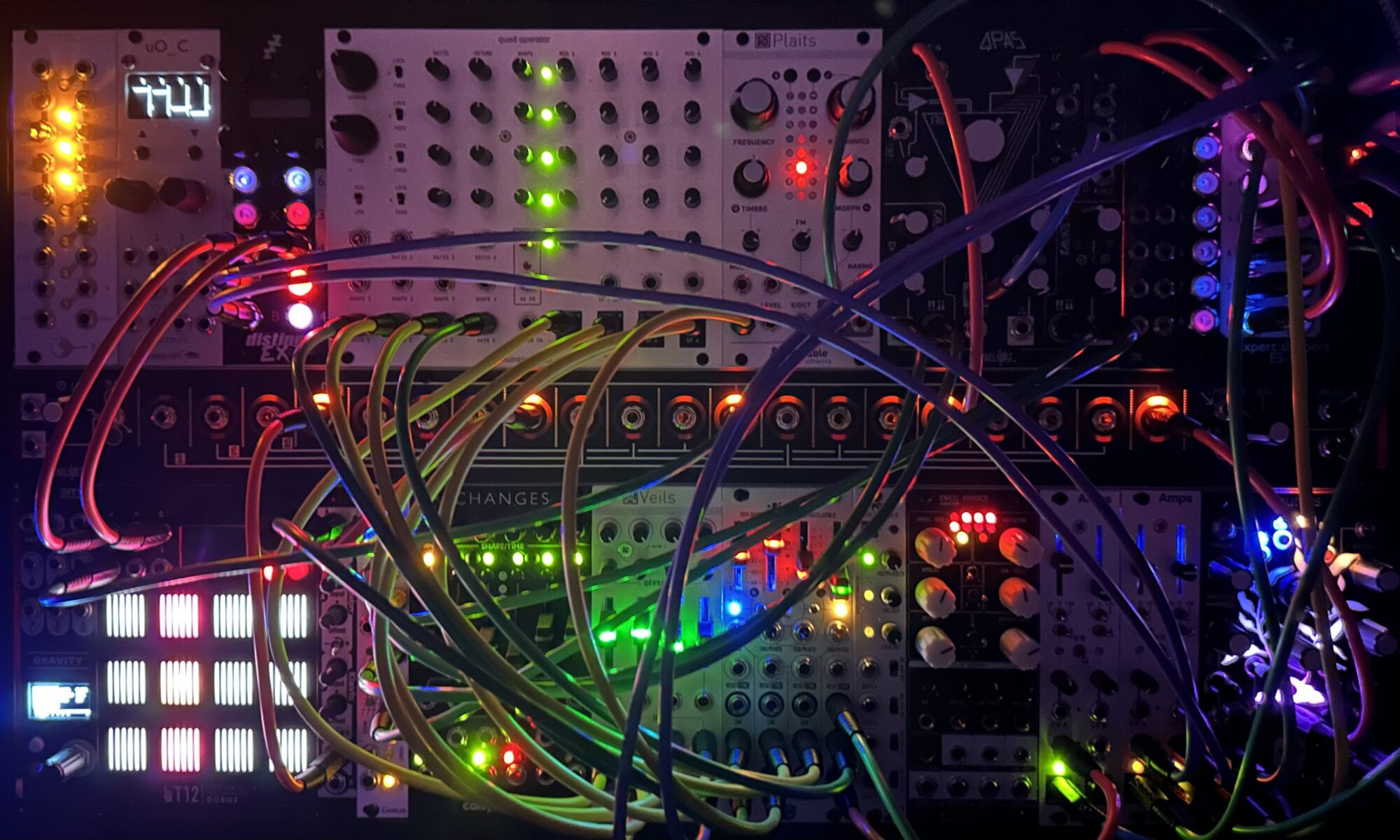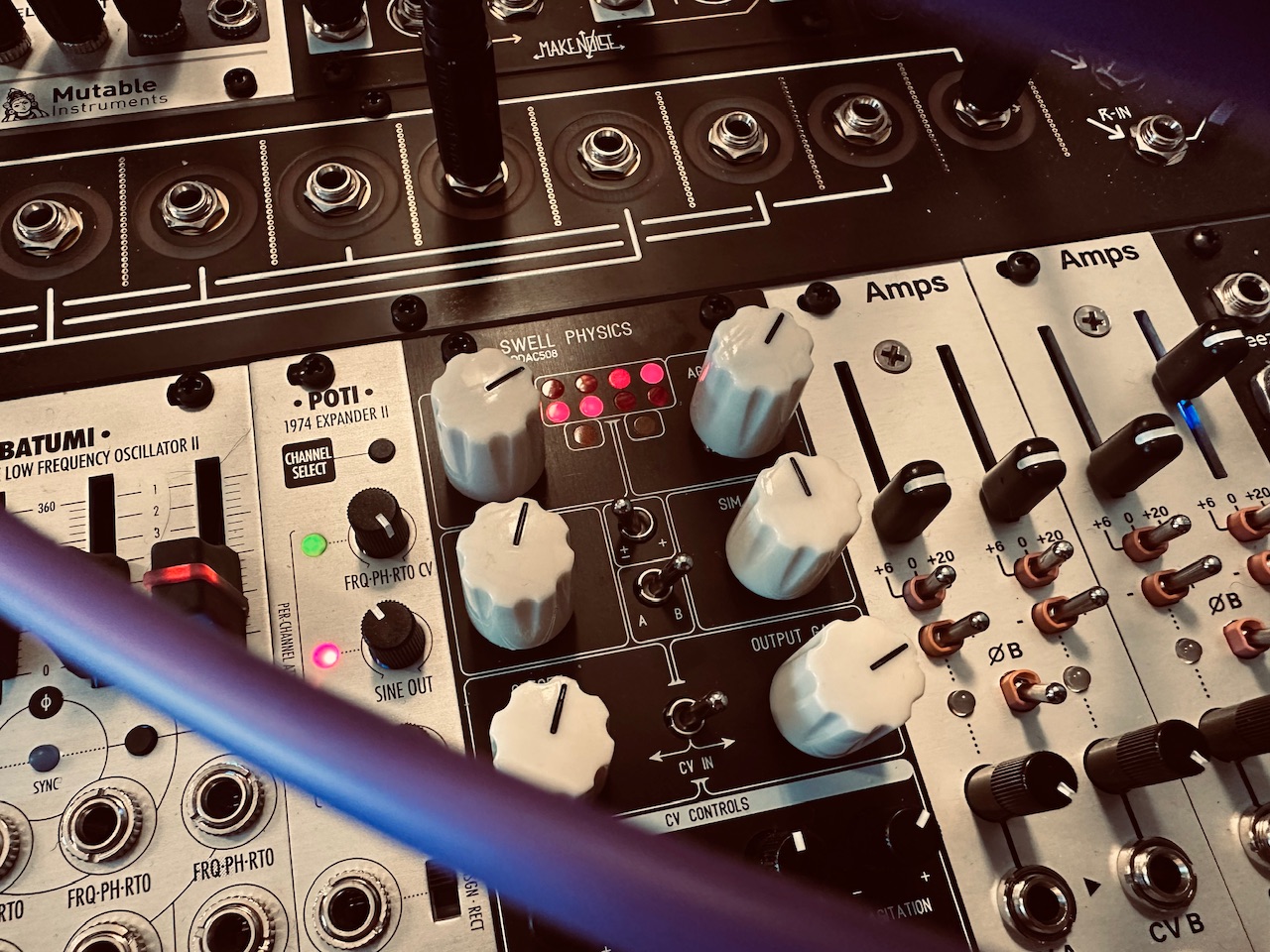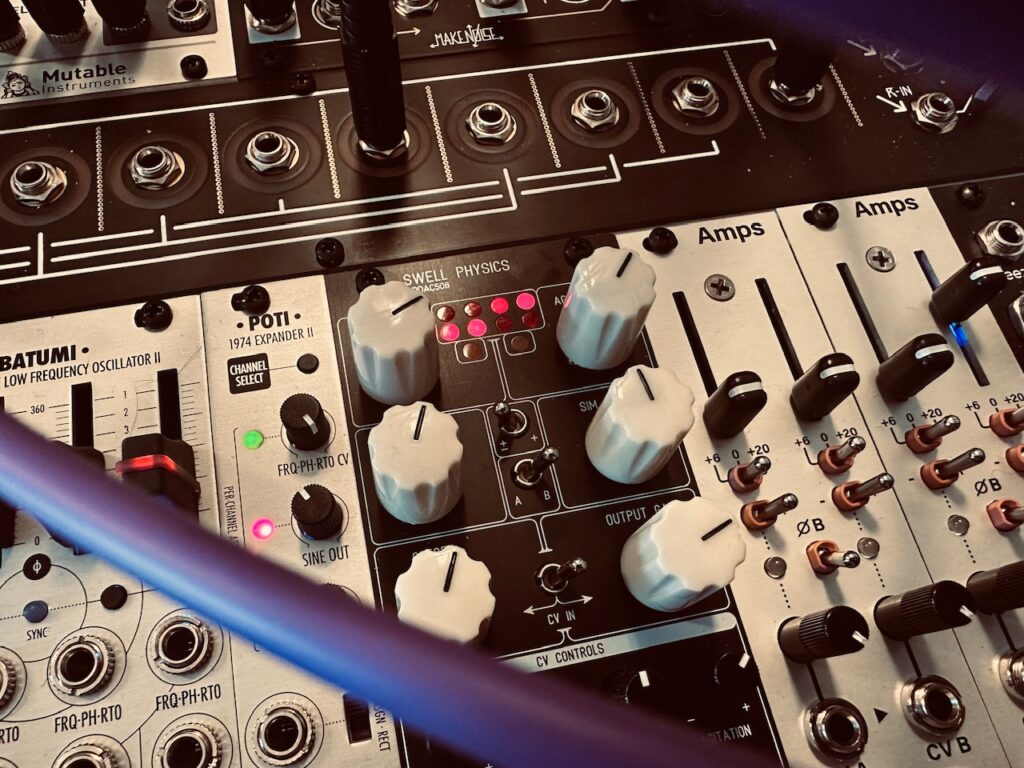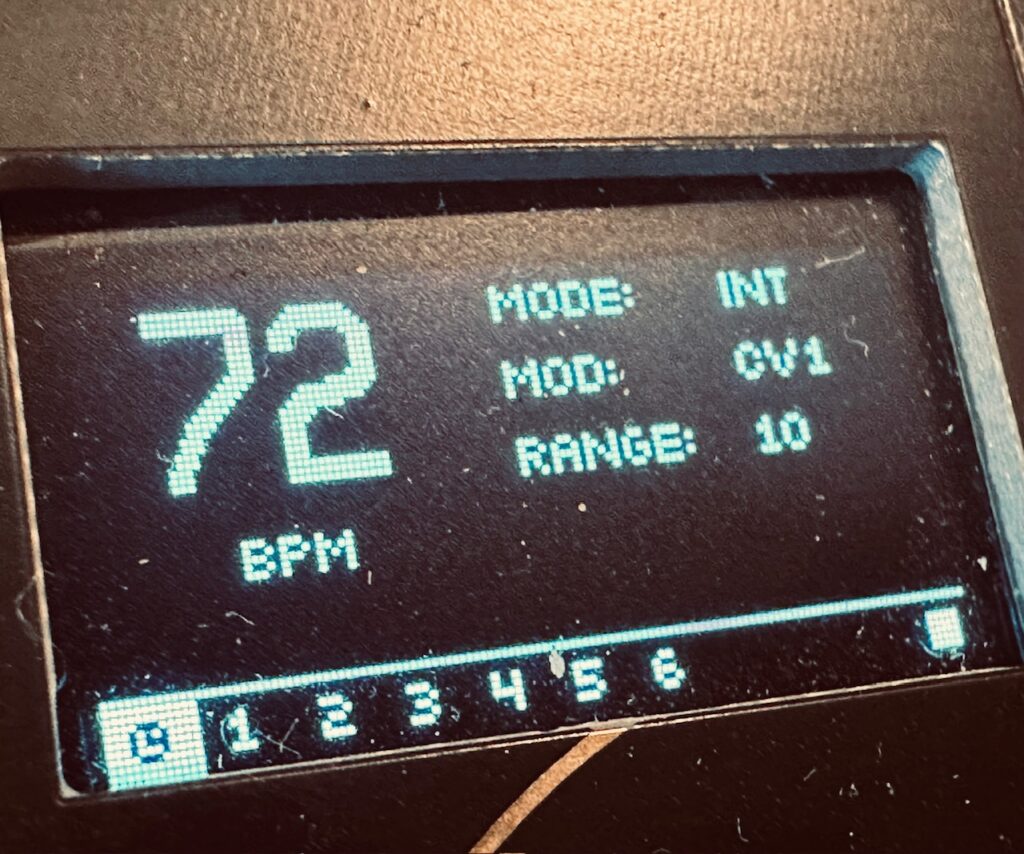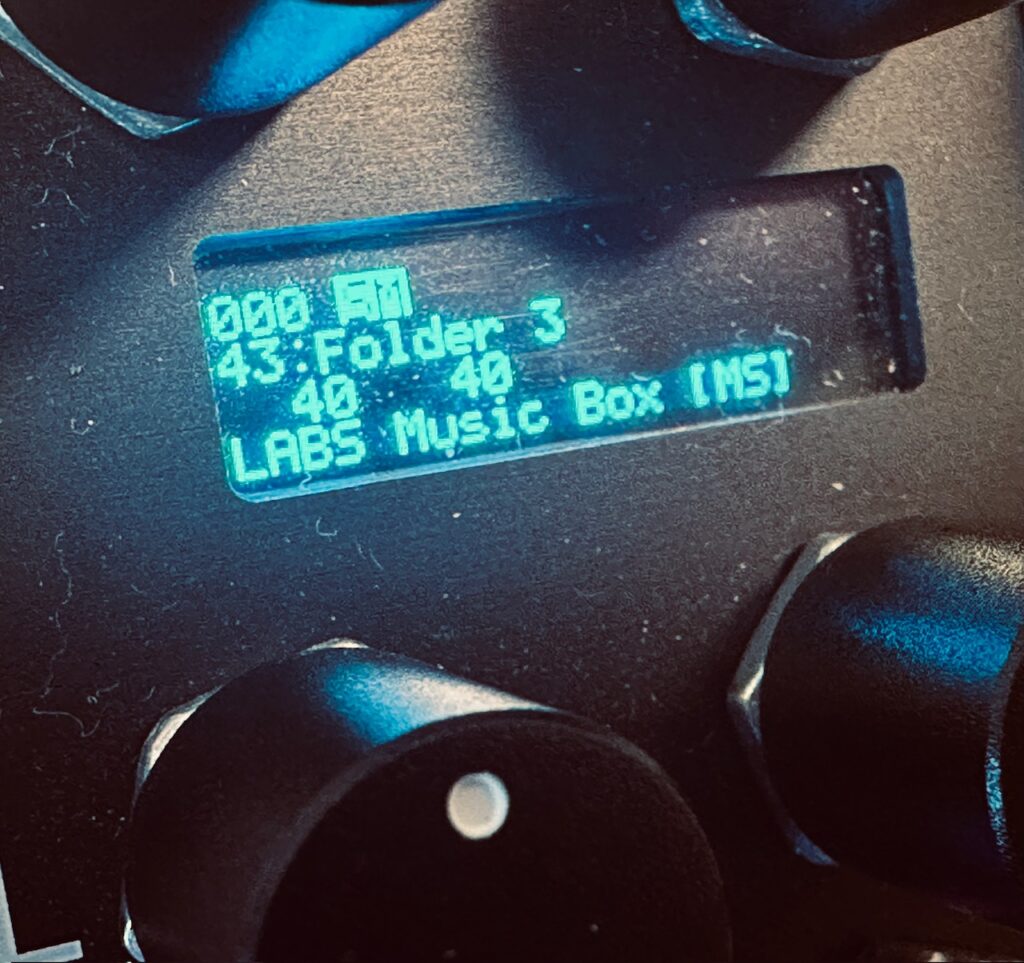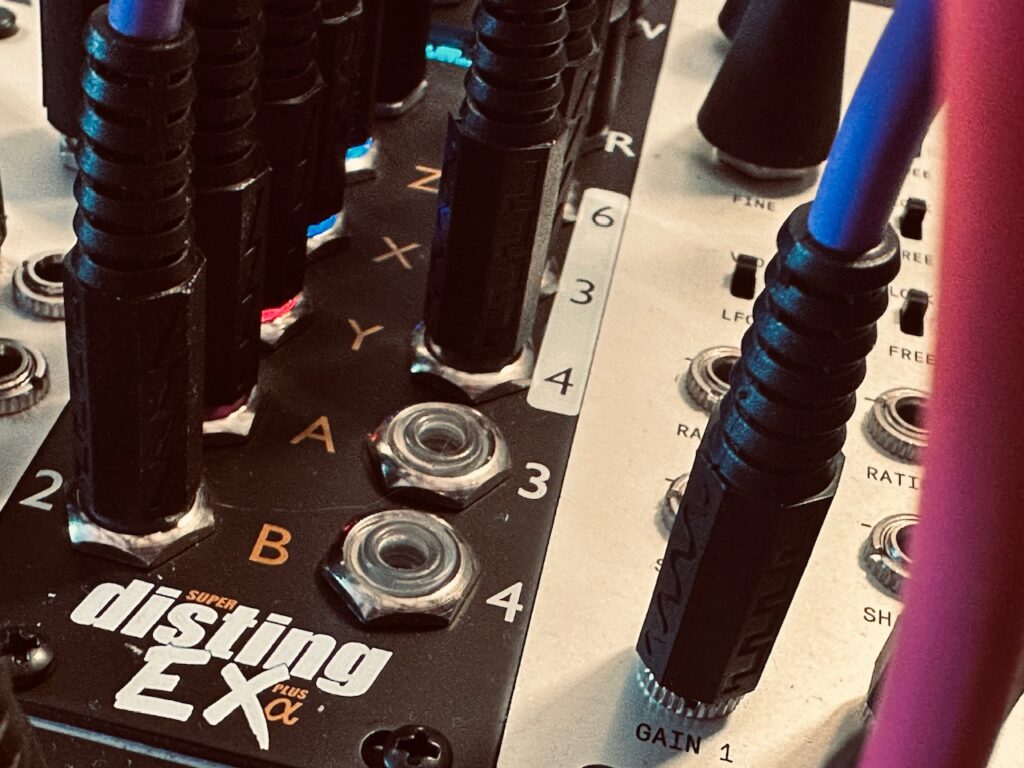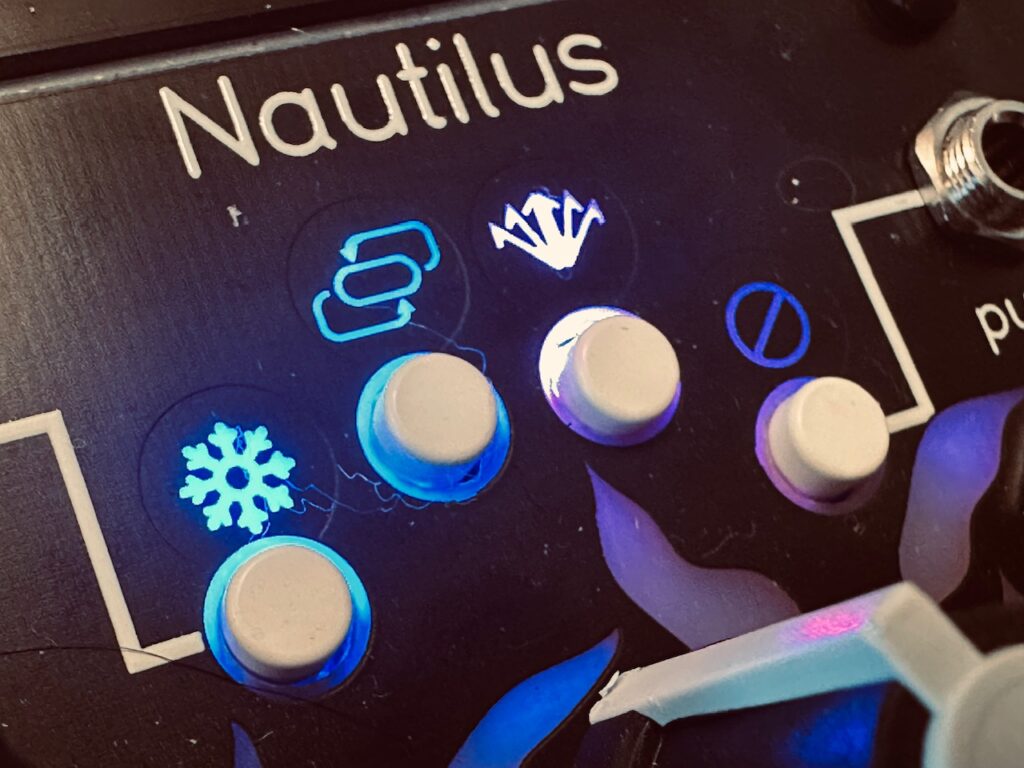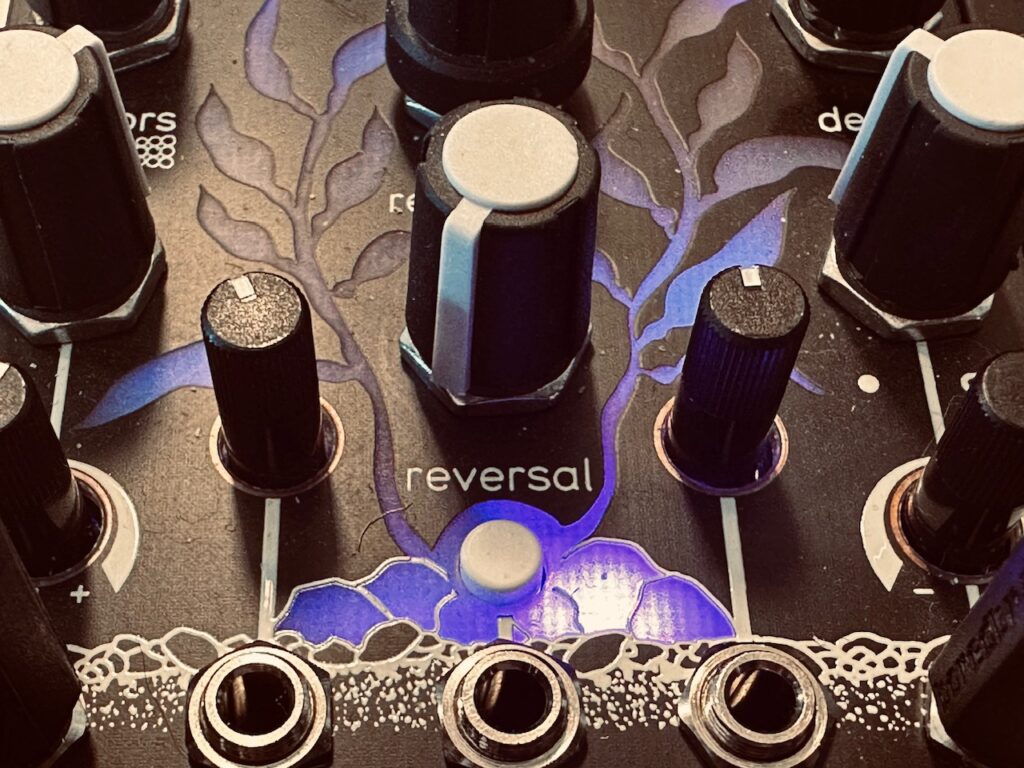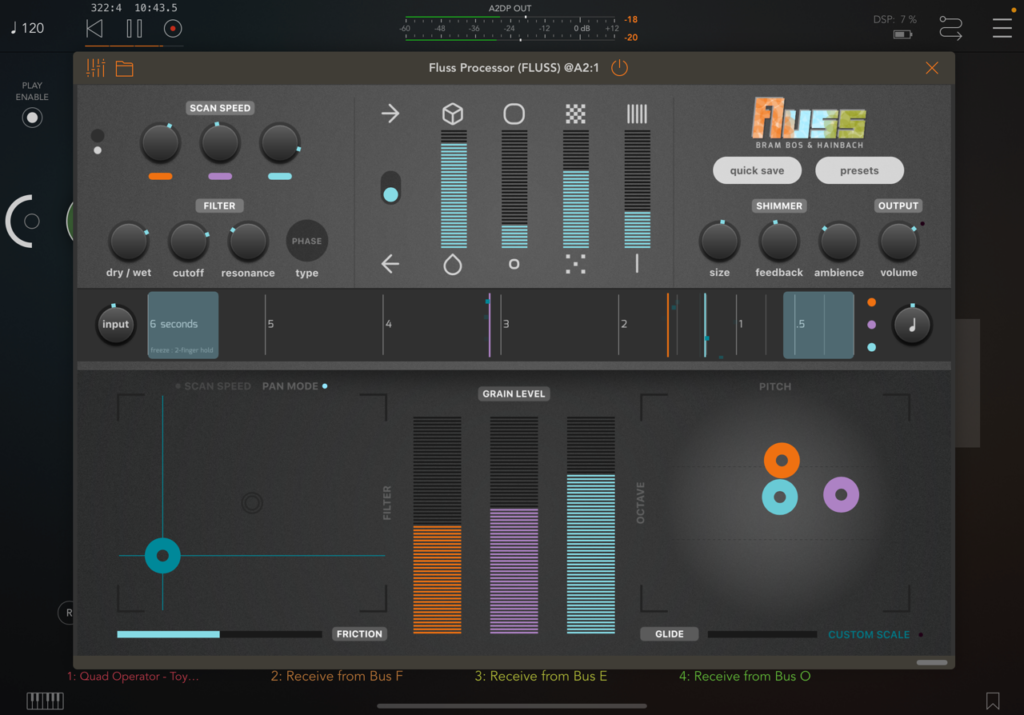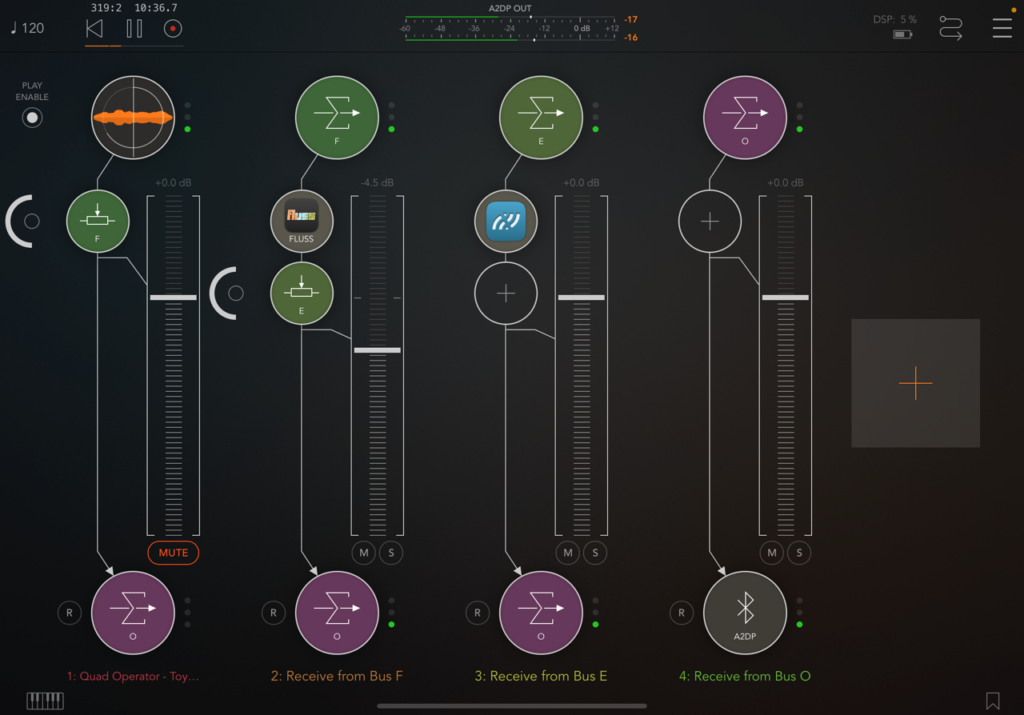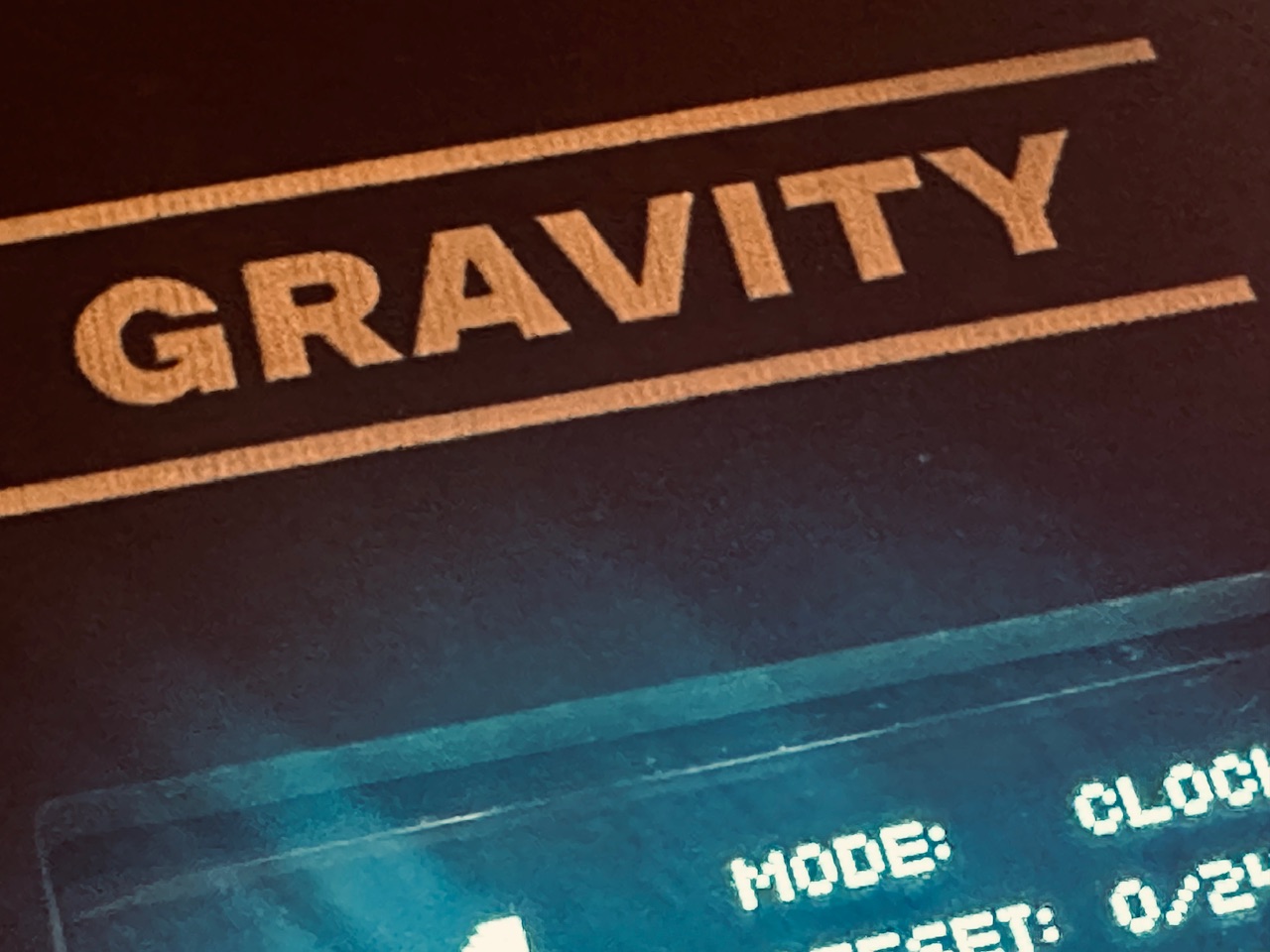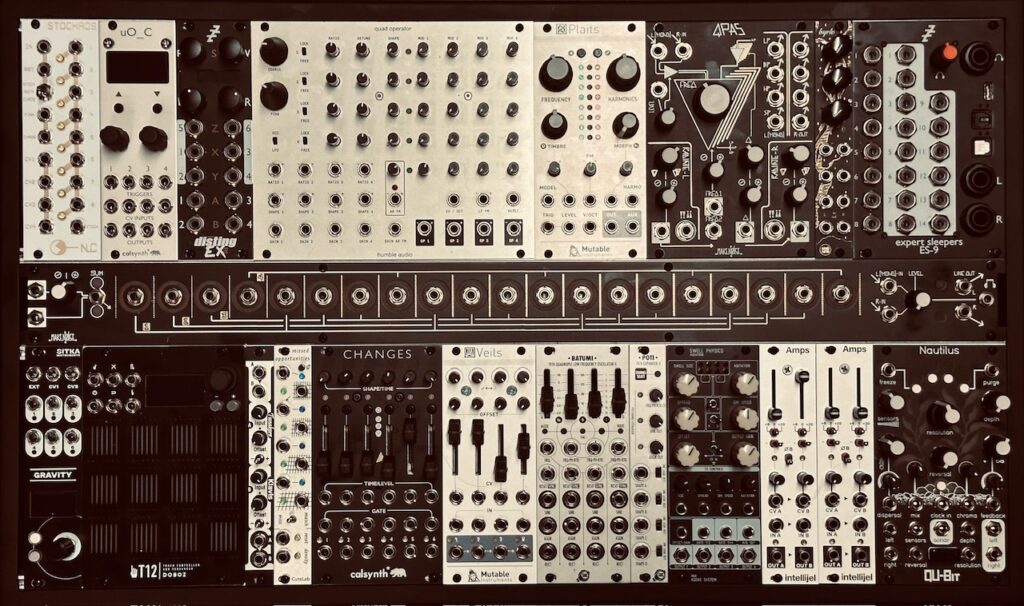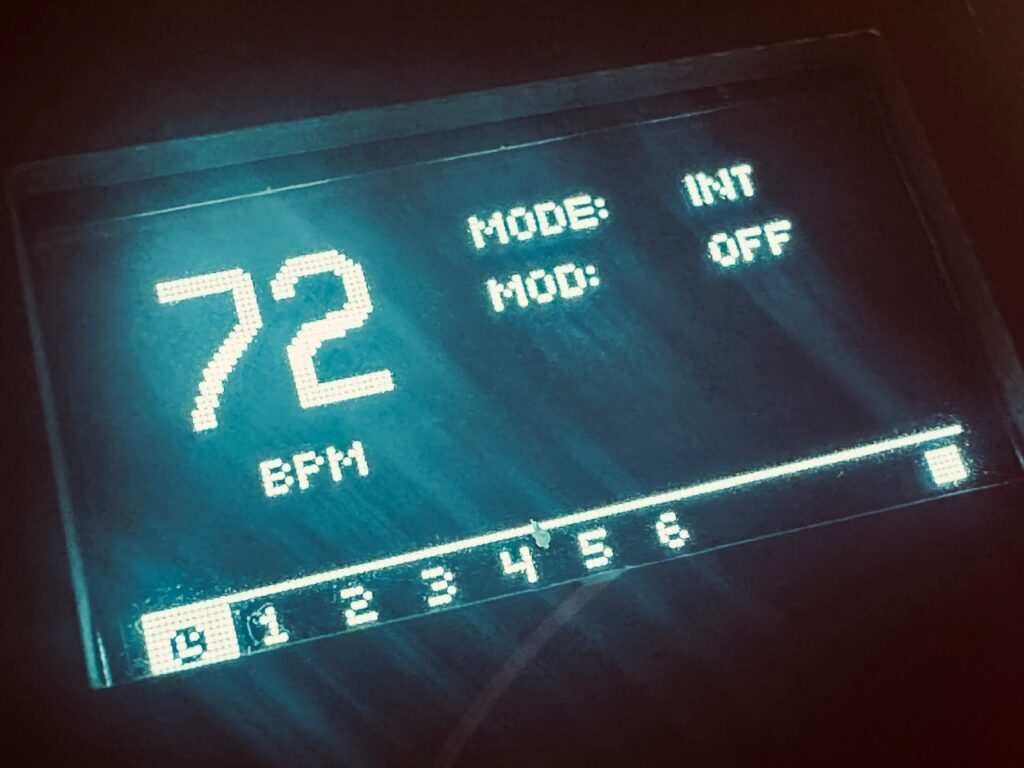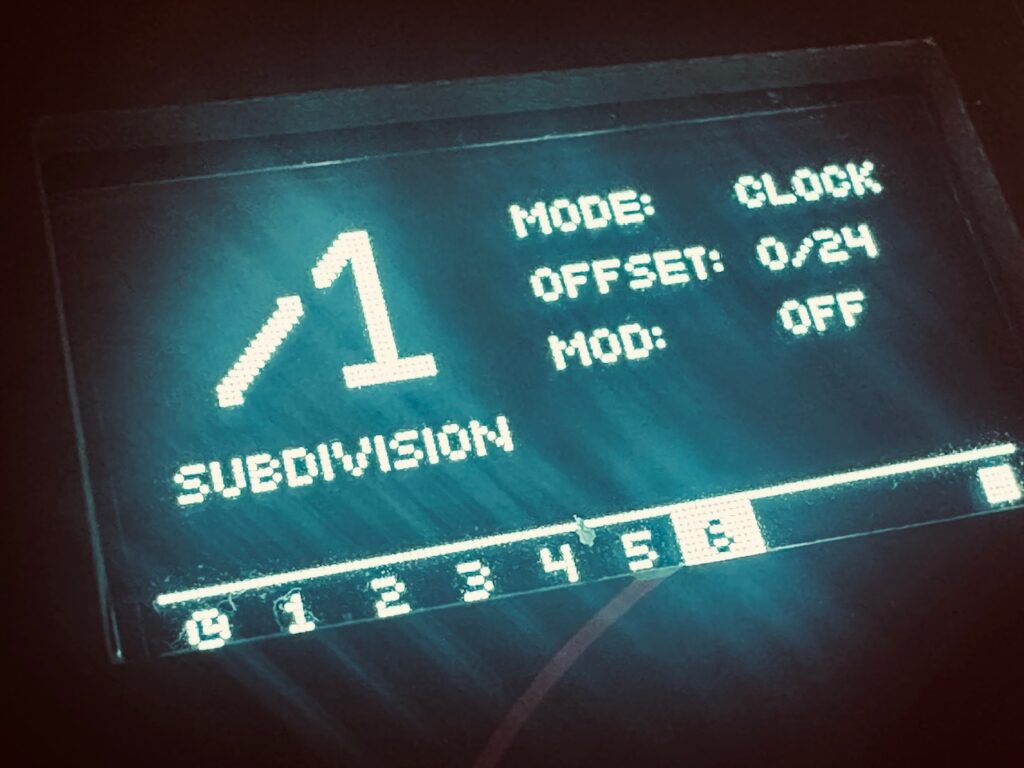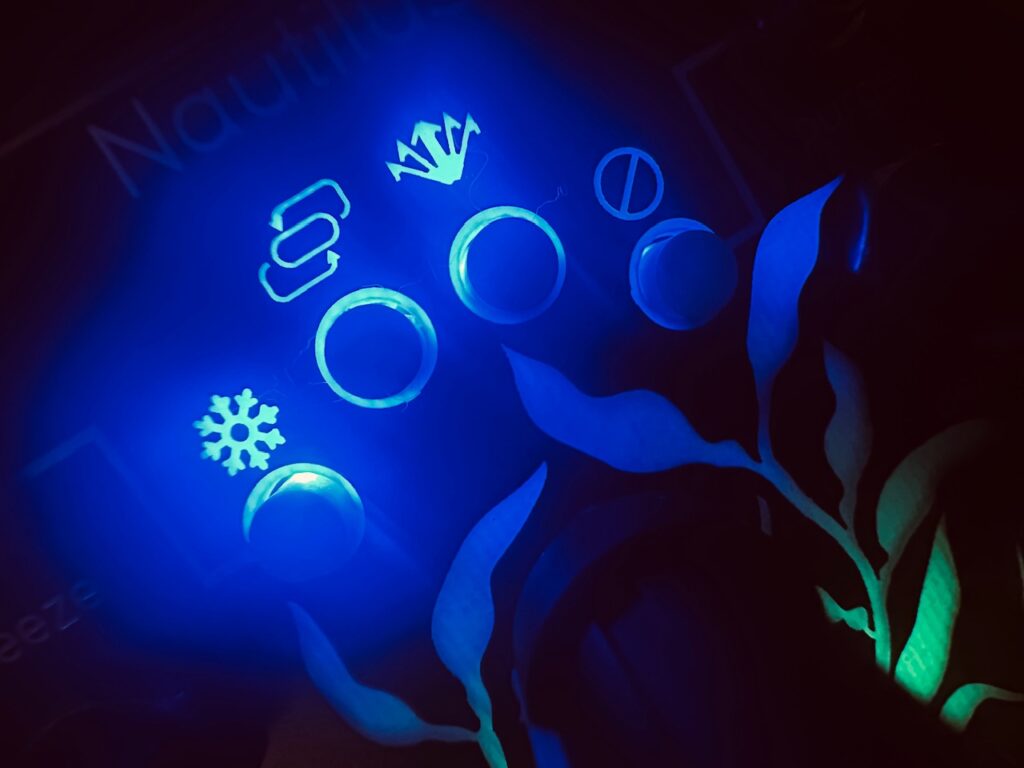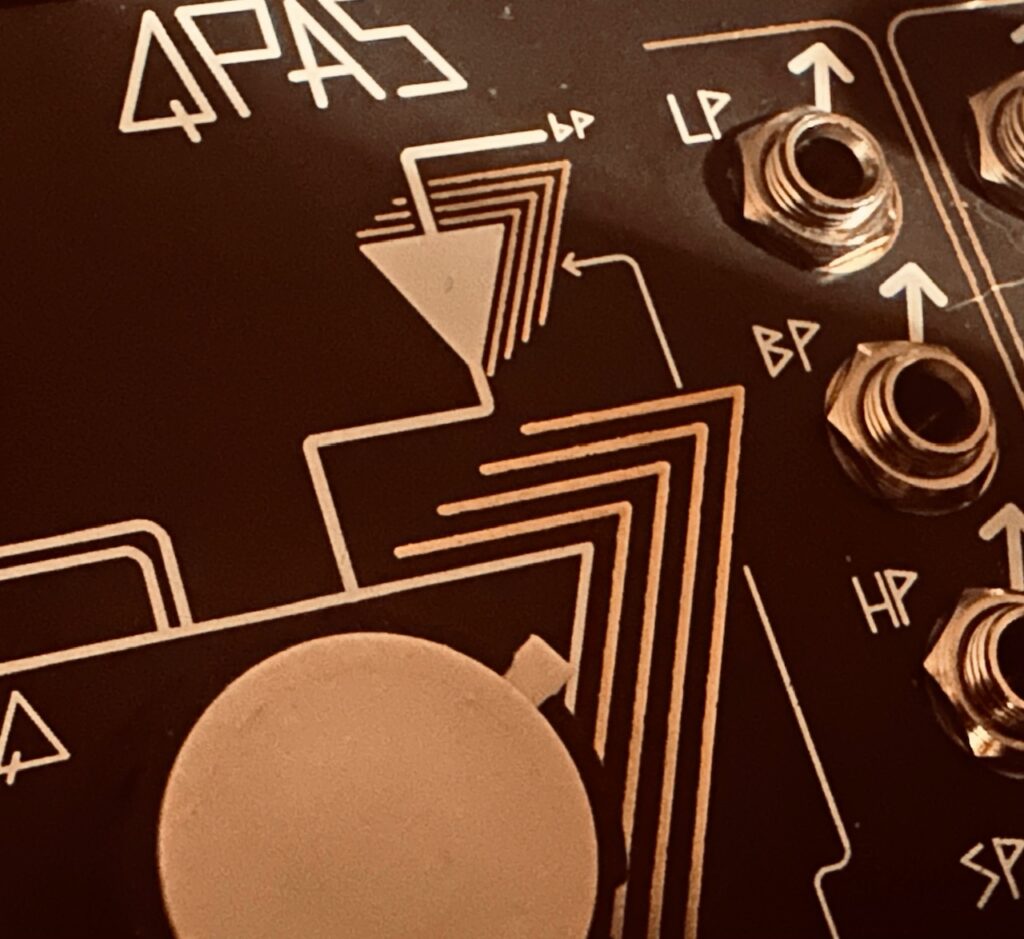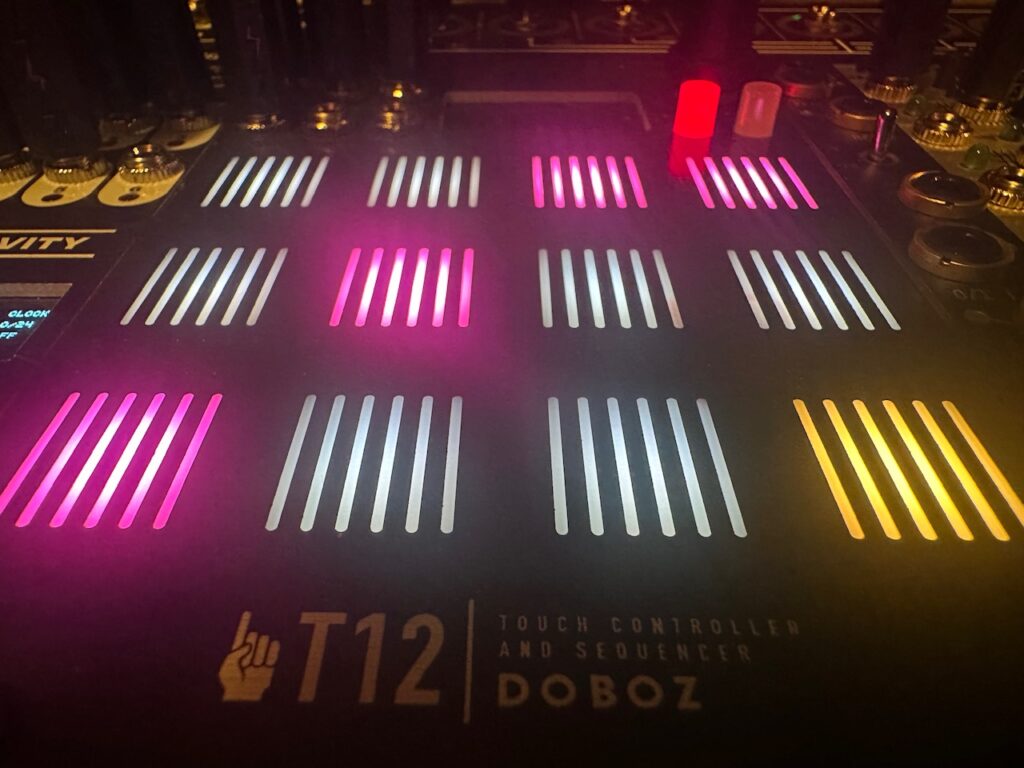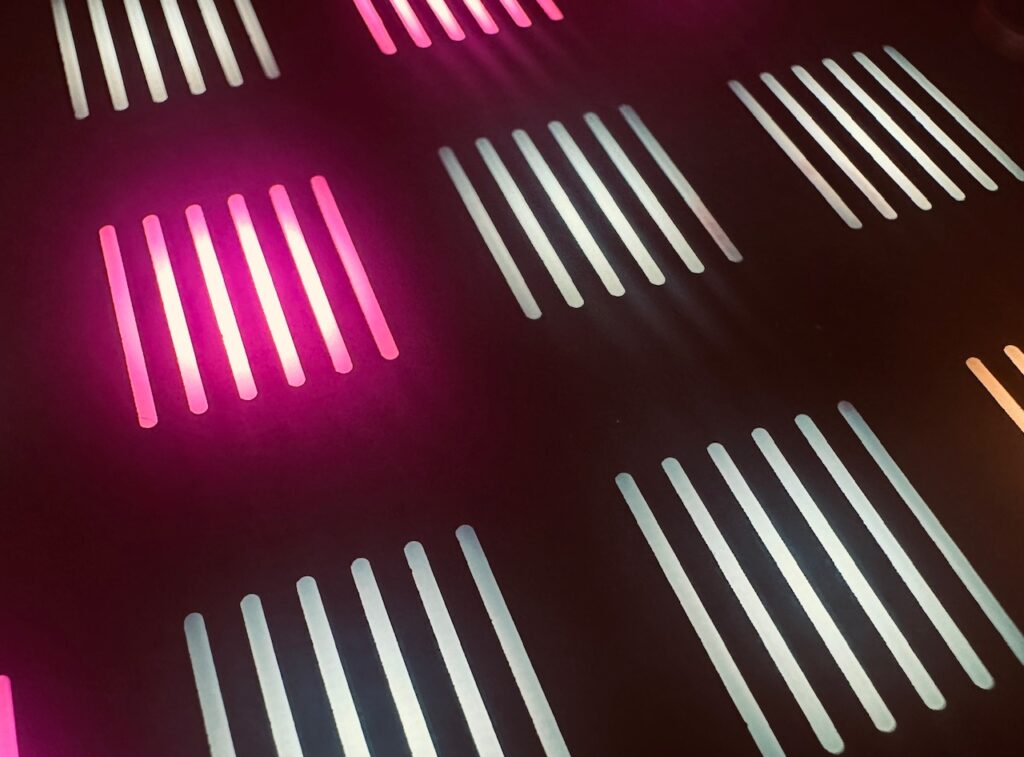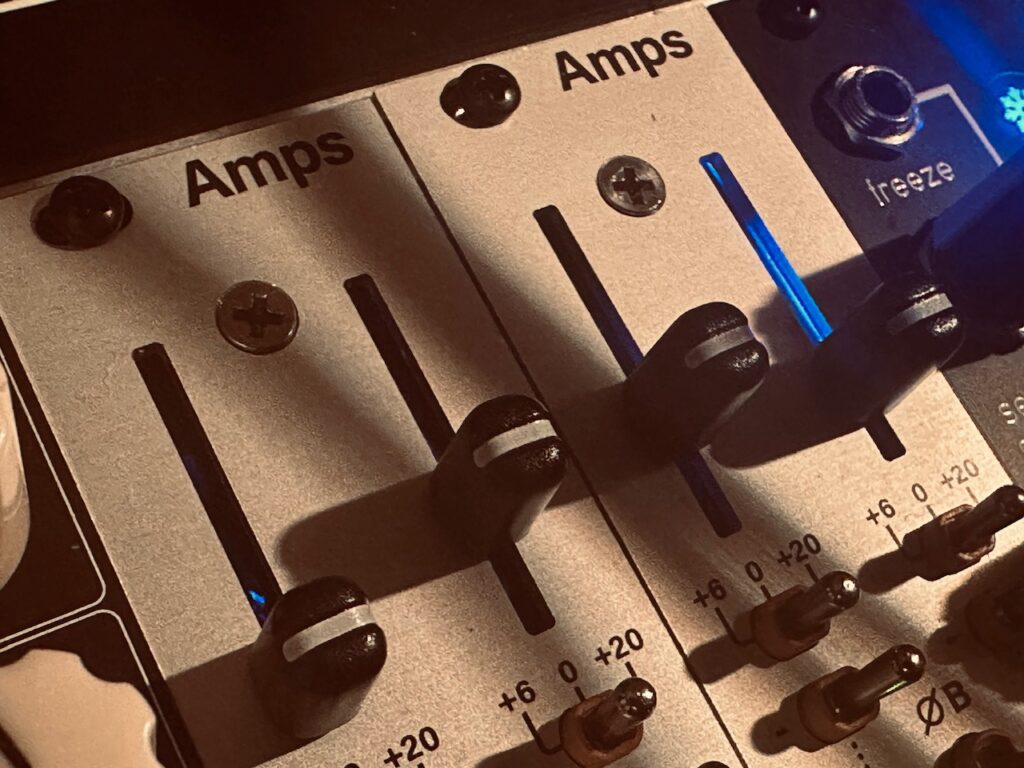The Daytime Patch
After a fantastic morning of sailing through Glacier Bay, I decided to spend the afternoon and evening patching while I watched the beautiful southeast Alaskan coast float by outside my cabin window, door ajar for the the sound and smell of the sea as inspiration. The first patch started simply enough, the Swell Physics four wave outputs into Quad Operator’s four gain inputs, through some delay and reverb, and out for your pleasure. But this time I decided to add a bit of variation via Batumi’s various wave shapes to modulate the wave shape of each of the operators. This modulation had the unanticipated effect of also modulating the apparent volume of the output as well, which created a very cool phasing effect of the individual waves as both their levels and wave shapes were being modulated at separate rates.
The four Quad Operator outputs are mixed down to stereo, then sent through QPAS which had moderately heavy modulation to the cutoff, both Radiance CV inputs, and with gates to both !!¡¡ inputs. I mixed both the LowPass and Smile Pass outputs at about a 75/25 ratio for some very cool stereo imaging, and sent the signal to Nautilus.
Although I’ve used the Chroma feature of the Qu-Bit Nautilus a lot, I’d never used the wavefolder in the feedback path. I’d never used it because I never said to myself, “Man, what this feedback path needs is wavefolding!” Overdrive, distortion, and bitcrushing sure, but unfortunately wavefolding was ignored. A pretty aqua color in the kelp light show on the panel between the orange overdrive and red distortion. This oversight was a dumb and tragic mistake, alleviated by the conscious choice to use wavefolding in this patch. Wavefolding in the feedback path sounds fantastic! Controlling feedback and the Depth of the Chroma is crucial because wavefolding, like distortion and bitcrushing, can create runaway feedback quickly if the balance between feedback and wavefolder isn’t closely watched. The effect, as modulated by a highly attenuated triangle wave from Batumi, created a mix between a nasally and almost fuzz-like tone where there are some edges of the sound starting to leak and sputter, particularly on lower tones.
As accompaniment I went with the LABS Choir samples in the Disting Ex SD Multisample algorithm, using three of the Swell Physics wave outputs for pitch, and the 1 < 2 and 3 > 4 gate outputs through the CuteLab Missed Opportunities as triggers. What I was watching go by as our ship rolled along the grand Alaskan coastline called for drama. Something that could create tension and with some occasional resolution. Although I might better tune the gates to get just the right amount of action if I were to record this patch again, it’s often too sparse, and with not enough harmonization, I feel like the Choir more or less created the effect I imagined, even if it sometimes veered from dramatic to an uneasy suspense. It’s a feel as much as anything else.
Both the Quad Operator > QPAS > Nautilus and the Disting Ex voices went to the mixer, and on to the Stratosphere Cloud Reverb.
Overall I like the direction of this patch, but it needs work. The waves from Swell Physics are often way too slow (a common occurrence once the simulation has been running for a while), and although the modulation from Batumi created some very cool phasing effects, it all combined into a slow moving soup. A soup with promise, but a soup nonetheless. There’s just no pace. Perhaps that’s a reflection of the glaciers I’d been watching all morning, but by the time I’d hit the Stop Recording button in AUM the patch seemed to have come to a crawl, begging for an ending. With time, this patch can be exquisite, but I need to put in the work to get it there.
The Night Time Patch
Once I’d hit stop recording on the daytime patch, I’d become slightly frustrated that I couldn’t get it where I wanted to take it. Either through lack of food, time, patience, feel, or some combination thereof, the patch ended with a whimper. I wasn’t satisfied. Having done several slow, ambient patches for the last several weeks, I knew I needed a change. I needed something to shake that ass to. Something to temper my disappointment in the daytime patch, and something to quell my desire to create something. But only after a visit to the buffet to both feed my body and cleanse my musical palette.
When I started patching again that evening I wasn’t exactly sure what I was going for. I knew I wanted something rhythmic and fun, but started in a way similar to how I’ve started lots of patches recently: four Batumi outputs going to the four gain inputs on the Quad Operator. But this time was different. Rather than using slow, randomly paced waves, as I would do in an ambient patch, I used clock divided LFOs to create a rhythm. Not only did each individual LFO create individual notes directly by lowering and raising the gain on each operator, but also created a rhythm via FM modulation.
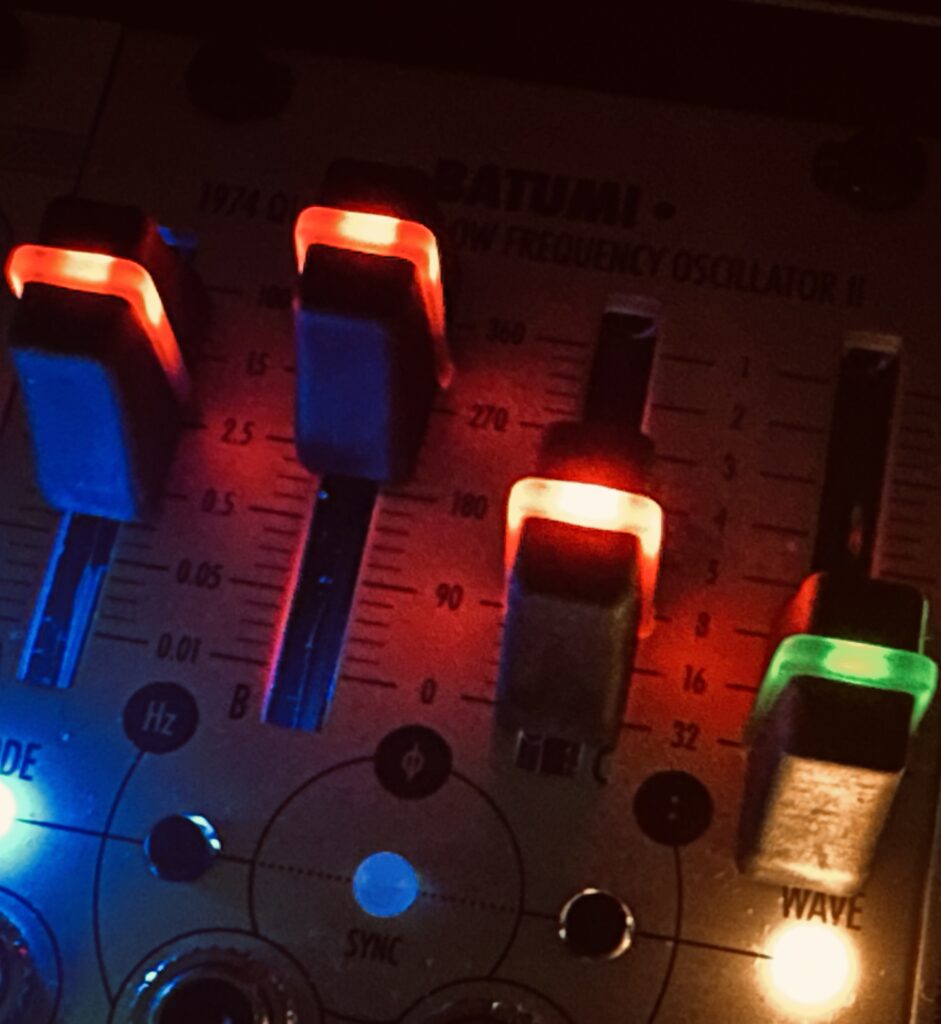
With the Quad Operator, when you’re using the Gain CV inputs, each operator is available at its output when the gain input has positive voltage, just like with any VCA. Likewise, each operator is also only able to act as a modulating oscillator for Frequency Modulation to the other operators via the Quad Operator’s FM Matrix when its gain is positive (or the Gain CV input is not patched), making each Gain CV input have an effect on more than just that operator’s output. Each Gain CV input also controls timbre in other operators’ outputs as well, drastically changing the complexion of the overall sound as these various LFOs fade in and out at different, but related speeds, and with differently shaped waves. Sometimes an operator is being FM’d. Sometimes not. It’s a nice way of being able to use all four of the Quad Operator’s outputs, even if tuning can get complex, rather than sacrificing operators to modulation duties only. It doesn’t make sense to use a FM synth like the Quad Operator in this fashion very often, but it works well in some styles of patching. The four operator outputs are routed to the Mutable Instruments Veils for a stereo mix down before going to the final mixer. From there it’s sent to the Blue Mangoo Stratosphere Cloud Reverb.
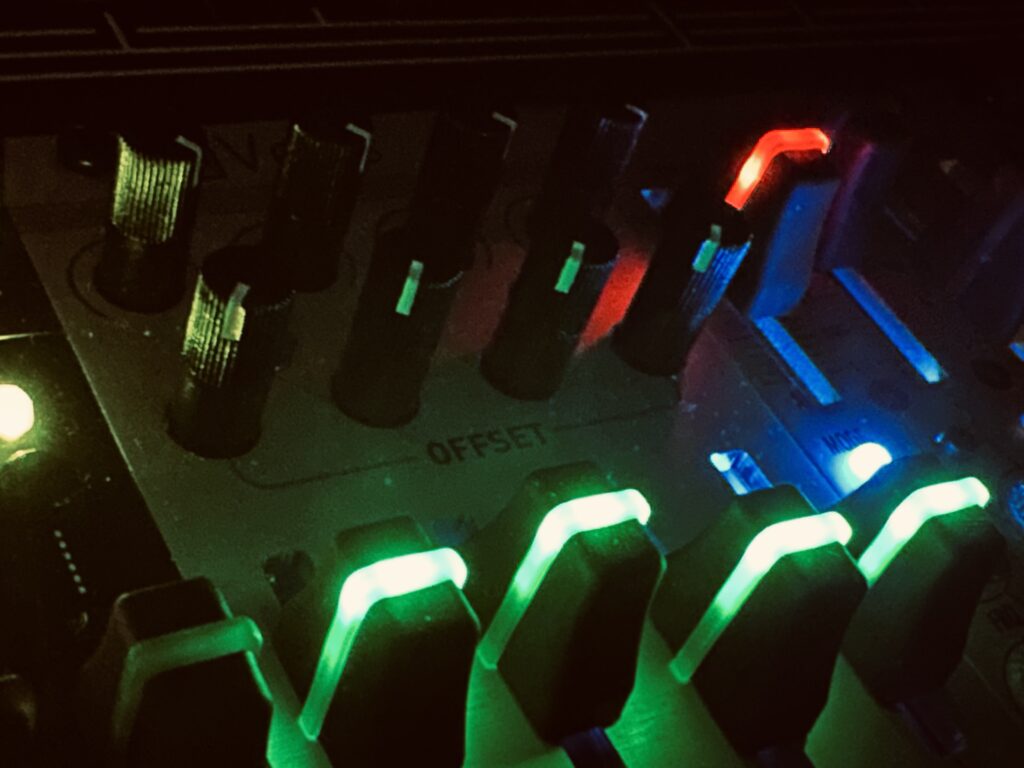
If I were to do a patch like this again, I would probably process one or more the Quad Operator outputs individually to add some spice, rather than immediately mixing them to stereo. To treat each of those outputs as individual entities unto themselves, rather than assimilating them into a larger body immediately after their creation, never allowing each to have their own existence. Sending one output or another through a separate effect or process than the others might help create something special that is lost once an individual signal is married to another in a mixer.
The kick drum is about as simple as it gets. A /2 square wave output from Batumi to Plaits, twist the knobs a bit until you find the timbre, decay, and pitch you want, and turn the FM trimmer to taste. One of the wonders of Plaits, and Braids before it, is its versatility. It can be almost anything you want it to be. From a FM oscillator to speech synthesis to kick drums and plucked strings, Plaits can make a whole lot of sounds and be the main voice in any patch. If you have something like the Jasmine And Olive Trees Traffic, or if you’re savvy with CV processing, Plaits can be many things at once. Today, however, Plaits was just a humble kick drum.
I had hoped to use QPAS in a more exciting manner. One of my favorite ways to use QPAS is by pinging it. But because QPAS normally lives isolated in a Make Noise only case, I haven’t really experimented much with pinging it without the using the nice, wide gates of both Tempi and René v2. But my clock in this case, the Sitka Gravity, doesn’t have any of those, and my sequencer, the T12, was already being used. Gravity outputs short triggers, about 15ms, which are great for telling something else it’s time to do its thing, but virtually useless as direct modulation, and the ability to use the gate’s length to help control modulation, such as with an ADSR envelope, is lost. I could ping the input with a trigger easily enough, but instead decided to use a probability gated square wave from Batumi via the CuteLab Missed Opportunities, which wasn’t quite the same as using the 50% duty cycle gates Tempi spits out. Although the developer of the Gravity has said that a gate mode, wherein the duty cycle of the gate will be adjustable, for now it’s all triggers. I could (should) have just used the triggers from Gravity to sync to Batumi and trigger envelopes from that unused Changes sitting there wondering why he was left out of the party, but it just didn’t occur to me until I was too deep in the patch to bother with changing it. With the Batumi square wave, the pronouncement of the modulation and ease of switching up the gate patterns just wasn’t there. You can hear the modulation well enough in isolation, but it’s almost nonexistent in the mix.
Despite my lack of imagination in modulating QPAS with unfamiliar tools, its role in the patch, however, is crucial. Its LP outputs add a marimba-like percussive element (thanks to feedback patching the left HP output to the highly attenuated Freq 1 input) to accompany the kick drum, and contribute a party-like atmosphere in the patch.
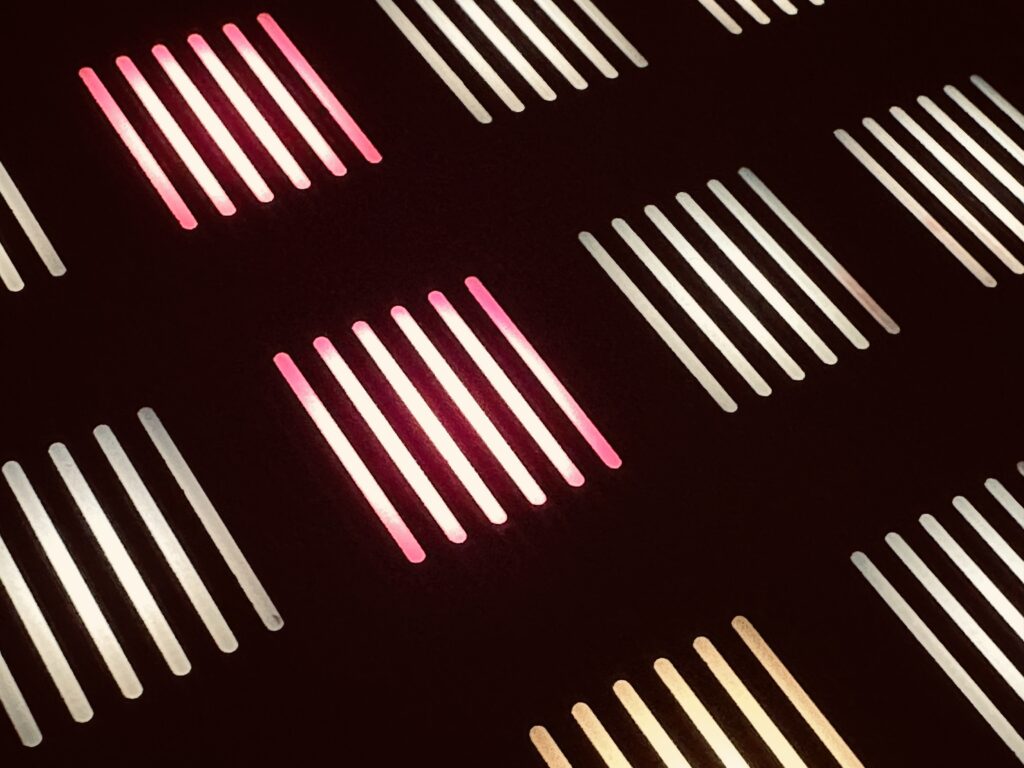
There are also two new-to-me elements to this patch that I hadn’t yet tried. The first is to use the Doboz T12 as an arpeggiator. Since the T12 is brand new, there are a lot of new things to try. It’s a deep, highly versatile module. I’ve used it as a sequencer, and as a touch controller (my over-70 mom also had a great time using it as a touch controller). In this patch I’d use it as an arpeggiator with the second new-to-me element: using the Poly Wavetable algorithm on the Disting Ex.
The T12 is turning out to be something akin to the greatest in-case touch controller in Eurorack. Of course I haven’t used many others, and those that I have used never tried to be quite as much as the T12 strives after, but the T12 seems to have some serious chops in terms of immediately challenging Eurorack mainstays like the Make Noise Pressure Points or Doboz’s own TSNM MKII. The T12’s main limitations are its inputs and outputs, and that it requires some level of menu diving . It only has three inputs and outputs. A pitch CV, an AUX CV, and a gate output, with clock and reset inputs, along with one solitary CV input. Something like Pressure Points can put out several voltages from several “channels” simultaneously, which is not something the T12 can do, but the T12 more than makes up for these shortcomings with flexibility, the customizability of each mode, and the ultra-intuitive user interface. The T12 is, by far, the easiest module I’ve used that has a screen based UI. Virtually all of the options for each mode are changed on the surface menu level, without any real diving at all. Doboz did a knockout job with designing the interface to be powerful, expansive, and super easy to navigate.
The T12 in use as an arpeggiator is smooth and ultra-fun. It will arpeggiate as many notes as you can get your fingers on, and the touch plates are very responsive when making changes. There’s generally enough space to maneuver use three or four fingers of one hand to make your note changes, but there are some button combos that require some serious hand dexterity, or the use of two hands. But once you get a feel for how to move your hand in the space, muscle memory starts to take over, and it’s nothing but pure fun. As with most arpeggiators there are several directions or patterns you can choose. This patch started with a forward pattern, and a 20% probability that a gate will be skipped, then, at some point, switched to a random direction, with a 20% probability that a gate will be skipped. There are many options I could have investigated, like the probability and range of pitch variability (by step or overall), or transposition, or using the AUX CV output, but I chose to keep it simple, and, quite frankly, I was having a really good time spending my night doing something simple and performative.
If I’m being honest, this patch was the first time I’ve used the Disting Ex in any algorithm other than the SD Multisample. The Disting Ex too is a deep, highly versatile module, to put it lightly, but I traded away a 1010 Music Bitbox Micro for a Disting Ex because of its capability as a multisample player, specifically that it can play eight simultaneous voices of polyphonic multisamples via pitch CV and gate inputs. No other module can do that in quite the same way. But I’d already used SD Multisample in my first patch on the trip, the Daytime Patch before this one, as well as my test patch before leaving. Every patch I’d made with this case included SD Multisample, and I wanted to try something new with this synth.
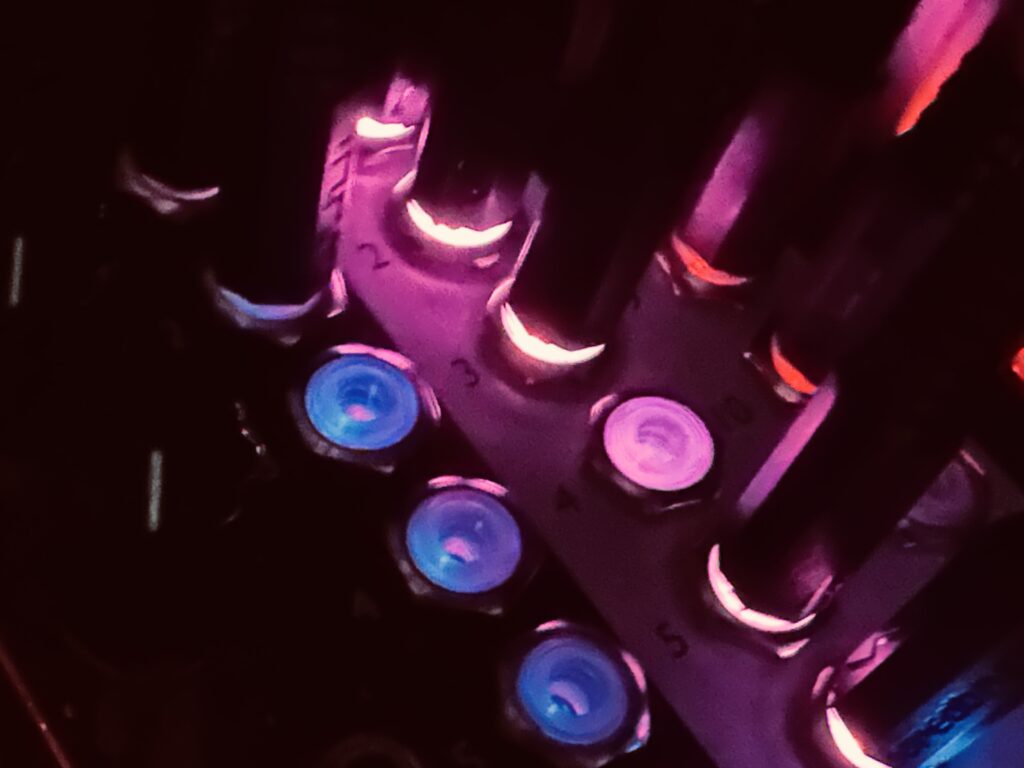
Because the patch was lively, I wanted to use a lively sound source for my arpeggios. Quad Operator was already in full use, and Plaits was thumping along as a kick drum, so I knew I needed to find another algorithm in the Disting Ex. If QPAS could self oscillate (without help), and if it could follow v/oct pitch CV, I probably would have used it as the arpeggiator voice either by pinging it (which QPAS does fantastically, as this patch shows), or as a sine wave oscillator through a VCA using the envelopes created by the T12. But QPAS doesn’t self oscillate or follow v/oct pitch CV, so the Disting Ex was the way. I could have chosen a completely unpatched CalSynth Changes, a very excellent MI Stages 1:1 clone, loaded with the latest quimem firmware in Ouroboros (Harmonic Oscillator) mode, but by the time I decided I wasn’t going to use Changes as a modulation source I was already set on using the Poly Wavetable algorithm in the Disting Ex.
Fortunately, Poly Wavetable is very similar to SD Multisample in how it functions. Poly Wavetable can take 3 CV sources and 3 gates and play up to 8 simultaneous voices polyphonically. That said, the weakness of the Disting UI and very small display becomes glaringly magnified when you need to make parameter changes, especially with nearly-50 eyes. You get a slew of options, several dozen, and a very tiny screen with which to navigate and make changes. I would have greatly preferred to control envelopes and such with a dedicated envelope generator outside of the Disting in a VCA or LPG, but I elected to use the internal envelope because I didn’t have any more VCAs to use, much less two of them. The 8 VCA channels (plus VCAs within modules like QPAS and Quad Operator) I brought with me were already in use doing other things, so fumbling through the menu system was the only way. Don’t get me wrong: the Disting Ex is incredibly powerful, and each algorithm is highly customizable. It sounds fantastic, and it can do dozens of operations from polyphonic multisample player to a pitch to CV generator, matrix mixer, or lots of other tasks. The Disting line, but particularly the Ex, is truly is the ultimate Swiss Army knife of Eurorack. Such a broad tool, that is also quite deep, is bound to be awkward sometimes. Since they’re built to do everything, it’s impossible to also have a UI that will match a good workflow for all of the algorithm functionality (perhaps, some might argue, for any of them). That said, the UI manages to be fairly simple to navigate. If you can see it. Most of the options are controlled on the surface level of the menu. You turn one encoder to change options, a second to change a parameter within that option, and click a third to save it.
Having listened back to the recording several times, I definitely wish that I had a pair of LPGs available to me in the case. That attack and intoxicating decay from a LPG would have been just the thing. The arpeggios in the Night Time patch are enunciated, but only just adequately. I never really got to shaping the internal ADSR envelope beyond shortening the release a bit, and the UI is actively hostile to changing while trying to perform. The UI really hindered me there, (I was trying to booty shake, not squint my eyes at a tiny screen trying to optimize my envelope), and that unused Changes was still staring at me with that sad face one gets when everyone except you were invited to the party. I know there are 3rd party screens for the Disting that alleviate the problem, this one came with one when I traded for it, but of the ~2200hp in my synth, my only 1u row is in the Make Noise 4 Zone Bus Case, which is occupied by a CV Bus Mk2, so it’s out of the question unless I decide to get two Distings.
This patch was a lot of fun to build and perform. I hope to patch in this same vein on my full synth soon enough.
One last tool that I used on this trip that I hadn’t really written much about, and that I bought specifically for this trip, is the Bolanle PH400 4-Channel Headphone Amp. Since the plan was to use this synth with my brother, I wanted a means to have independent volume control. I loathe having to share volume control of headphones, and so decided on a small headphone amplifier. Although the PH400 is certainly not something I’d call studio worthy, I can say that it’s a good piece of kit, and it met all of my requirements. It had to be powered by USB C, small and portable, and it had to have individual control, and it had to sound good or better. I wanted something with both sized headphone outputs for each channel to avoid adapters, and the PH400 has that. Each channel also has its own mute button. As an added bonus, the LED light show is cool. This thing works great.
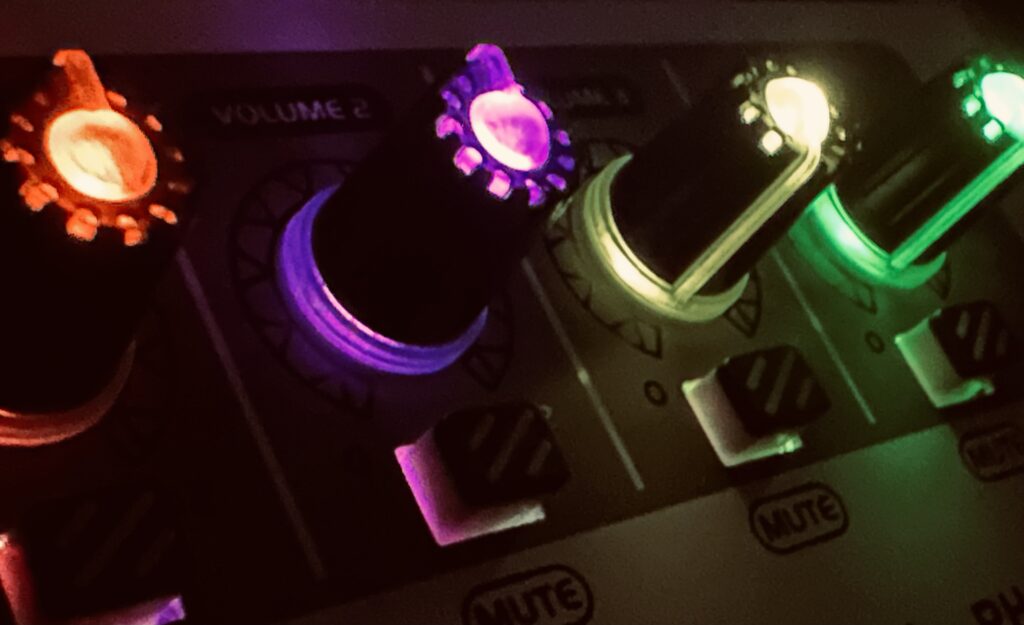
Modules Used (Daytime Patch):
Addac Systems Addac508 Swell Physics
Xaoc Devices Batumi II + Poti II
Humble Audio Quad Operator
Make Noise QPAS
Qu-Bit Electronix Nautilus
CuteLab Missed Opportunities
Expert Sleepers Disting Ex (SD Multisample – LABS Choir)
Mutable Instruments Veils
Intellijel Amps
AUv3 Plugins Used:
Blue Mangoo Stratosphere Cloud Reverb
***
Modules Used (Night Time Patch):
Xaoc Devices Batumi II + Poti II
Humble Audio Quad Operator
Make Noise QPAS
Expert Sleepers Disting Ex (Poly Wavetable)
Mutable Instruments Plaits
Mutable Instruments Veils
Intellijel Amps
Klavis Tweakers
Doboz T12
Qu-Bit Electronic Nautilus
AUv3 Plugins Used:
Blue Mangoo Stratosphere Cloud Reverb
